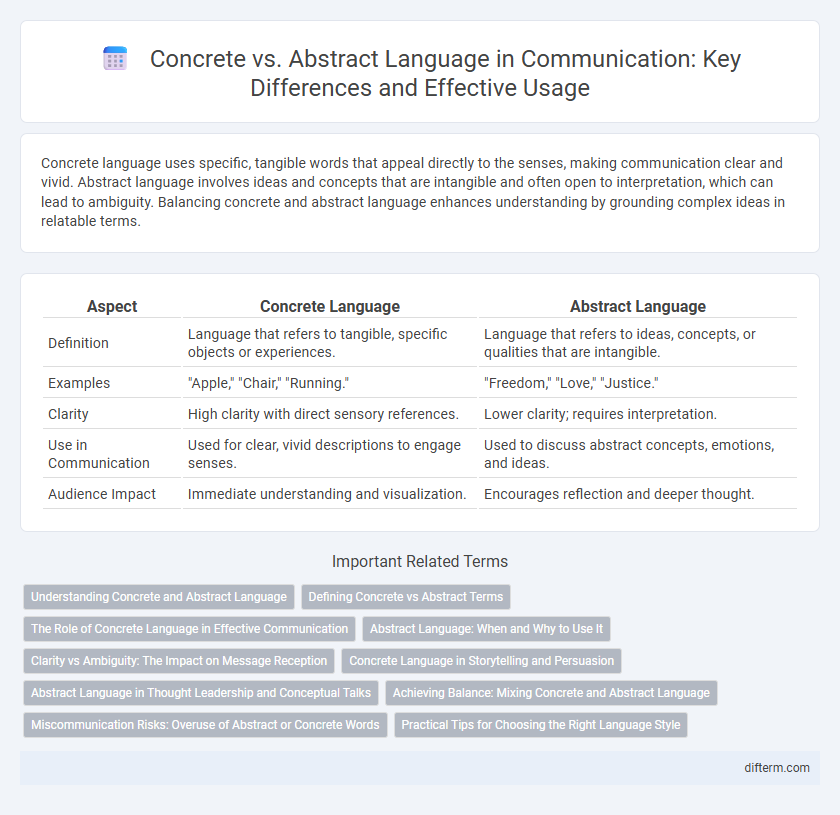Concrete language uses specific, tangible words that appeal directly to the senses, making communication clear and vivid. Abstract language involves ideas and concepts that are intangible and often open to interpretation, which can lead to ambiguity. Balancing concrete and abstract language enhances understanding by grounding complex ideas in relatable terms.
Table of Comparison
| Aspect | Concrete Language | Abstract Language |
|---|---|---|
| Definition | Language that refers to tangible, specific objects or experiences. | Language that refers to ideas, concepts, or qualities that are intangible. |
| Examples | "Apple," "Chair," "Running." | "Freedom," "Love," "Justice." |
| Clarity | High clarity with direct sensory references. | Lower clarity; requires interpretation. |
| Use in Communication | Used for clear, vivid descriptions to engage senses. | Used to discuss abstract concepts, emotions, and ideas. |
| Audience Impact | Immediate understanding and visualization. | Encourages reflection and deeper thought. |
Understanding Concrete and Abstract Language
Concrete language uses specific, tangible words that appeal directly to the senses, making communication clear and easily understood. Abstract language involves ideas, concepts, and feelings that are intangible, requiring higher cognitive processing and interpretation. Mastering the balance between concrete and abstract language enhances effective communication by ensuring clarity while conveying deeper meaning.
Defining Concrete vs Abstract Terms
Concrete terms refer to words that describe tangible, physical objects or specific sensory experiences, such as "apple," "dog," or "warmth." Abstract terms denote ideas, qualities, or concepts that cannot be perceived directly through the senses, like "freedom," "love," or "justice." Understanding the difference between concrete and abstract language enhances clarity and effectiveness in communication by matching word choice to the intended message and audience.
The Role of Concrete Language in Effective Communication
Concrete language enhances effective communication by providing clear, specific details that help listeners visualize and understand the message. It minimizes ambiguity and reduces the risk of misinterpretation, making interactions more precise and impactful. Using tangible examples and measurable data strengthens engagement and ensures clarity across diverse audiences.
Abstract Language: When and Why to Use It
Abstract language is essential when discussing complex ideas, emotions, or concepts that lack physical form, such as freedom, justice, or love. It enables speakers to convey nuanced meanings and engage audiences in critical thinking by allowing for interpretation and reflection. Using abstract language strategically enhances persuasive communication, fosters deeper understanding, and supports theoretical or philosophical discussions.
Clarity vs Ambiguity: The Impact on Message Reception
Concrete language enhances clarity by providing specific, tangible details that reduce ambiguity, making messages easier for audiences to understand and recall. Abstract language, while useful for expressing complex ideas or emotions, can introduce ambiguity that challenges message reception and interpretation. Effective communication balances concrete examples with abstract concepts to optimize clarity and engagement.
Concrete Language in Storytelling and Persuasion
Concrete language in storytelling enhances clarity and vivid imagery by using specific, tangible details that engage the audience's senses and emotions. This approach strengthens persuasion by making arguments more relatable and memorable, fostering trust and connection between the speaker and listeners. Effective communicators often blend concrete examples with abstract ideas to anchor complex concepts in real-world experiences.
Abstract Language in Thought Leadership and Conceptual Talks
Abstract language in thought leadership fosters deeper engagement by emphasizing ideas, principles, and theories rather than specific details. This approach encourages audiences to connect with overarching concepts and envision innovative possibilities beyond concrete examples. Utilizing metaphorical and conceptual terms enhances persuasive communication and drives strategic vision in high-level discussions.
Achieving Balance: Mixing Concrete and Abstract Language
Effective communication relies on blending concrete and abstract language to achieve clarity and depth. Concrete language anchors ideas by using specific, tangible details that enhance understanding and engagement. Abstract language introduces broader concepts and creativity, enabling deeper reflection and nuanced expression.
Miscommunication Risks: Overuse of Abstract or Concrete Words
Excessive use of abstract language increases miscommunication risks by creating ambiguity and reducing message clarity, often leading to varied interpretations based on individual experience. Conversely, relying too heavily on concrete words may limit expression and fail to convey complex ideas effectively, causing misunderstandings in nuanced discussions. Balancing abstract and concrete terms enhances precision and ensures clearer communication across diverse audiences.
Practical Tips for Choosing the Right Language Style
Choosing the right language style hinges on the communication goal and audience needs; concrete language with specific details enhances clarity and engagement in instructional or technical contexts. Abstract language suits conceptual discussions, fostering reflection and broader interpretation in philosophical or theoretical communication. Tailoring language by blending concrete examples with abstract concepts optimizes understanding and impact across diverse communication settings.
concrete vs abstract (language) Infographic

 difterm.com
difterm.com